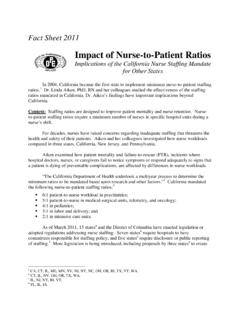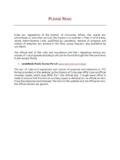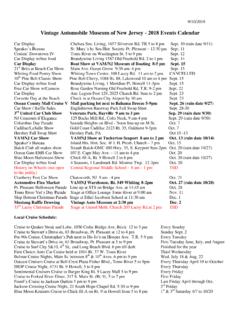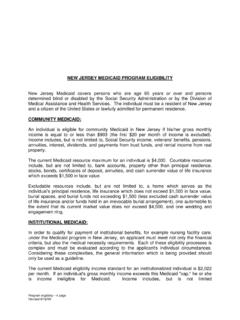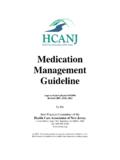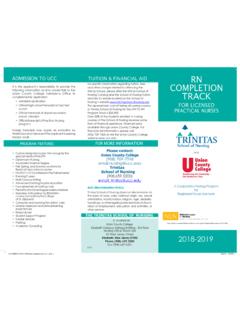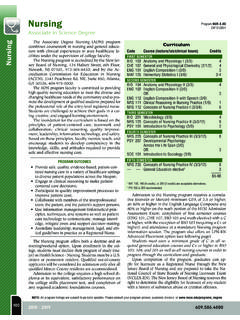Transcription of SAFE-STAFFING RATIOS: BENEFITING NURSES AND PATIENTS
1 Fact Sheet 2013 SAFE-STAFFING ratios : BENEFITING NURSES AND PATIENTS NURSES have an integral role in the health care system. State-mandated SAFE-STAFFING ratios are needed to ensure the safety of both PATIENTS and NURSES . Adequate nurse staffing is key to patient care and nurse retention, while inadequate staffing endangers PATIENTS and drives NURSES from their profession. staffing problems will only intensify as baby boomers age and the need for health care grows, making SAFE-STAFFING ratios an ever-pressing concern. This fact sheet outlines: the workplace and patient treatment improvements associated with SAFE-STAFFING ratios , the dangers of understaffing for NURSES and PATIENTS , the high costs of frequent nurse turnover in hospitals, the potential benefits of safe staffing for addressing the nursing shortage, the savings associated with SAFE-STAFFING ratios , and the growing popularity of SAFE-STAFFING legislation. SAFE-STAFFING ratios Improve the Workplace and Patient Care In 2004, California became the first state to implement minimum nurse -to-patient staffing ratios , designed to improve patient care and nurse retention.
2 Subsequent studies show that California s program measurably improved patient care and nurse retention. According to a 2010 study by researchers at the University of Pennsylvania, only 29 percent of NURSES in California experienced high burnout, compared with 34 percent of NURSES in New Jersey and 36 percent of NURSES in Pennsylvania, states without minimum staffing ratios during the period of research. The study also found that only 20 percent of NURSES in California reported dissatisfaction with their jobs, compared with 26 percent and 29 percent in New Jersey and California nurse staffing ratios accompanied a lower likelihood of in-patient death within 30 days of hospital admission than in New Jersey or Pennsylvania. In California, there was also a lower likelihood of death from failing to properly respond to symptoms. California reported percent fewer surgical deaths than New Jersey and 10 percent fewer surgical deaths than According to a 2007 study on safe staffing in Medical Care, an increase of one registered nurse (RN) per patient was associated with a 24 percent reduction in time spent in the intensive care unit and a 31 percent reduction in time spent in surgical In long-term care facilities, PATIENTS with more direct RN time (30 to 40 minutes daily per patient) reported fewer pressure ulcers, acute care hospitalizations, urinary tract infections, urinary catheters, and less deterioration in their ability to perform daily living Minimum staffing legislation has a direct impact on poor and uninsured PATIENTS .
3 A Journal of Hospital Medicine study found that hospitals with a high proportion of Medicaid and uninsured PATIENTS were significantly more likely to be above minimum nurse - DPE Fact Sheet Page 2 of 7 SAFE-STAFFING ratios : BENEFITING NURSES and PATIENTS to-patient ratios than hospitals with low proportions of Medicaid As discussed below, understaffed facilities pose a much greater risk to PATIENTS health. Understaffing Endangers NURSES and PATIENTS According to the American NURSES Association (ANA), Massive reductions in nursing budgets, combined with the challenges presented by a growing nursing shortage have resulted in fewer NURSES working longer hours and caring for sicker PATIENTS . This situation compromises care and contributes to the nursing shorting by creating an environment that drives NURSES from the bedside.
4 6 Working long hours and with inadequate staffing affects NURSES health, increasing their risk of musculoskeletal disorders (MSDs back, neck, and shoulder injuries), hypertension, cardiovascular disease, and depression. In 2011, 15 percent of all occupational injuries and illnesses in the occurred in health care and social assistance. In that year there were approximately 171,530 incidents in health care and social assistance requiring days away from NURSES cardiovascular health suffers as a result of working long shifts and overtime. In a 2010 study, researchers showed a clear trend between frequent overtime work and incidents of heart disease, with workers reporting three to four hours of overtime per day being times more likely to have cardiovascular health Many RNs also complain that current workloads are causing burnout. Burnout can be described by a number of symptoms, including chronic fatigue, irritability, insomnia, headaches, back pain, weight gain, depression, and high blood According to a study in the Journal of the American Medical Association, each additional patient over four per nurse carries a 23 percent risk of increased burnout and a 15 percent decrease in job In August 2012, approximately one-third of NURSES reported an emotional exhaustion score of 27 or greater, considered by medical standards to be high burnout.
5 11 Besides the occupational hazards caused by understaffing, numerous studies show a correlation between inadequate nurse staffing and poor patient outcomes. High nurse -to-patient ratios are associated with an increase in medical errors, as well as patient infections, bedsores, pneumonia, MRSA, cardiac arrest, and accidental Every one additional patient added to a hospital staff nurse s workload is associated with a seven percent increase in hospital A 2008 study by the Centers for Medicare and Medicaid Services found that facilities with staffing levels in the bottom 30 percent were more likely to be among the worst 10 percent of facilities for heart failure, electrolyte imbalances, sepsis, respiratory infection, and urinary tract Long-term PATIENTS in understaffed facilities, measured by staffing below hours of daily aide time and hours of daily RN time per patient, had a greater probability of poor outcomes such as pressure ulcers, skin trauma.
6 And weight Large patient loads and high levels of exhaustion among NURSES were associated with greater rates of urinary-tract and surgical-site infections among PATIENTS in a study published in the August 2012 issue of the American Journal for Infection DPE Fact Sheet Page 3 of 7 SAFE-STAFFING ratios : BENEFITING NURSES and PATIENTS Another recent study, this one published in The New England Journal of Medicine, examined the relationship between mortality and day-to-day, shift-to-shift variations in unit level staffing . The study found that the risk of death increased two percent each time a patient was exposed to shifts with below target RN staffing . The average patient in the study was exposed to three nursing shifts with below target staffing resulting in a six percent higher risk of mortality than PATIENTS ; the risk of mortality was four percent higher when a patient was exposed to a high turnover Researchers at the Center for Health Outcomes and Policy Research at the University of Pennsylvania s School of Nursing have concluded that lowering the patient-to- nurse ratios markedly improves patient outcomes in hospitals with otherwise good work Understaffing Leads to Expensive Human Resources Problems The demands of the nursing profession are forcing many NURSES to consider part-time nursing, or alternative careers.
7 In a 2011 survey, close to 45 percent of the surveyed NURSES said they planned to make career changes in the next one to three years, with over one-third of those surveyed considering careers outside of nursing According to the American Association of Colleges of Nursing, the average RN cost-per-hire is around $2, Other studies estimate the overall turnover cost per RN at $65, Another study showed that the average hospital is estimated to lose about $300,000 per year for each percentage point increase in annual nurse In addition to enforcing mandatory overtime, employers often use supplemental NURSES to temporarily fill gaps in nurse staffing . These temporary NURSES are more likely to be concentrated in hospitals with poor staffing rates and inadequate resources. Temporary NURSES make up between five and 15 percent of hospital nursing staffs in 55 percent of hospitals. 23 Supplemental nursing staffs are expensive, especially when they are brought in from outside agencies.
8 Hospitals generally pay between $250,000 and $400,000 for staffing agency services for every one million dollars spent on temporary- nurse Temporary NURSES are often compensated at rates 25 percent to 40 percent above the average RN s wages, further adding to cost and contributing to resentment among permanent As the percentage of temporary NURSES employed goes up, the quality of patient care tends to go down. Hospitals with temporary nurse staffing under five percent reported fewer hospital-acquired infections and fewer patient falls than hospitals with temporary nurse staffing at five to 15 percent. The percentage of nurse work-related injuries was also significantly higher in hospitals where temporary NURSES made up more than 15 percent of the total nursing SAFE-STAFFING ratios May Help Combat the Nursing Shortage A long-standing nursing shortage poses a challenge to the health care industry. According to the Bureau of Labor Statistics Employment Projections 2010-2020 released in February 2012, the Registered Nursing workforce is the top occupation in terms of job growth through 2020.
9 It is expected that the number of employed NURSES will grow from million in 2010 to million in 2020, an increase of 712,000 or 26 percent. The projections further explain the need DPE Fact Sheet Page 4 of 7 SAFE-STAFFING ratios : BENEFITING NURSES and PATIENTS for 495,500 replacements in the nursing workforce bringing the total number of job opening for NURSES due to growth and replacements to million by SAFE-STAFFING ratios may be an effective way to help combat the shortage and fill vacancies by attracting students to the profession and encouraging experienced NURSES to return to the profession. Many researchers have found that factors such as mandatory overtime are inversely associated with NURSES intention to stay in their Recent reports also indicate that many new NURSES leave their hospital positions within one year of starting Soon after nurse -to-patient ratio regulations went into effect in January 2004, the California Board of Nursing reported being inundated with RN applicants from other states.
10 That year, applications for nursing licenses increased by more than 60 percent. By 2008, vacancies for registered NURSES at California hospitals plummeted by 69 In Aiken s 2010 study, both NURSES and nurse managers agreed that the ratio legislation achieved its goals of improving recruitment and retention of NURSES , reducing nurse workloads, and improving the quality of SAFE-STAFFING ratios Do Not Financially Burden Hospitals While some critics of safe staffing claim that mandatory nurse -to-patient ratios burden hospitals with high operational costs, the majority of research shows that SAFE-STAFFING ratios are cost-effective. High turnover rates and high levels of temporary nurse staffing increase the average costs per discharge (cost of inpatient care, including administration) and overall operating costs. safe staffing improves nurse performance and patient-mortality rates, reduces turnover rates, staffing costs, and liability. One study in the Journal of Health Care Finance reported that increased nurse staffing did, indeed, increase operational costs for hospitals; however, it did not decrease the hospitals overall A 2009 study found that adding an additional 133,000 RNs to the hospital workforce across the would produce medical savings estimated at $ billion in reduced patient care costs.
